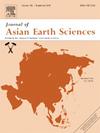西南独龙矿床形成过程中成矿流体的时空演化:与成矿作用的联系
IF 2.4
3区 地球科学
Q2 GEOSCIENCES, MULTIDISCIPLINARY
引用次数: 0
摘要
独龙矿床是中国西南地区一个重要的锡硫化物矽卡岩矿床,蕴藏着重要的稀土资源(7000吨)。虽然对In的发生进行了详细的研究,但对其时空分布和控制因素的了解仍然很少。本研究系统分析了流体包裹体、绿泥石地球化学特征,并结合已发表的闪锌矿中In含量,综合考察了成矿流体演化及其对In成矿的影响。流体包裹体资料显示,独龙地区可识别s型、l型和v型三种类型的流体包裹体。s型包裹体主要出现在辉石中,并与l型包裹体共存,表明发生了流体沸腾。流体均一温度和盐度从顺行阶段(468 ~ 560℃,44.7 ~ 49.6% NaCleqv)到逆行阶段(365 ~ 375℃,3.1 ~ 3.7% NaCleqv)显著降低,表明可能与大气水混合。从逆行到硫化物阶段,温度和盐度均略有下降(从365 ~ 375℃降至210 ~ 365℃,从3.1% ~ 3.7% NaCleqv降至0.3% ~ 2.6% NaCleqv),推测流体冷却可能是硫化物沉淀和相关富集的关键因素。绿泥石结果表明,从露天矿底部到顶部,微量元素浓度的变化主要与热液运移过程中温度的降低有关。流体温度与闪锌矿中铀浓度的增加有关,表明温度控制着铀的富集。绿泥石中Ti/Sr比值指示满家寨矿块底部可能存在热液中心(深度约1152 m),表明独龙矿床可能为远端矽卡岩型矿床。本文章由计算机程序翻译,如有差异,请以英文原文为准。
The temporal and spatial evolution of ore-forming fluids during the formation of the Dulong deposit, Southwest China: Linkage with in mineralization
The Dulong deposit is a major cassiterite-sulfide skarn deposit in Southwest China, hosting significant In resources (7,000t). Although the occurrence of In has been studied in detail, its spatiotemporal distribution and controlling factors remain poorly understood. This study therefore systematically analyzes fluid inclusions, chlorite geochemistry, and combined with published In contents from sphalerite to comprehensively examine ore-forming fluid evolution and its impact on In mineralization. The fluid inclusions data show that S-type, L-type, and V-type can be recognized at Dulong. The S-type inclusions predominantly occur in pyroxene from prograde stage and coexist with L-type inclusions, suggesting that fluid boiling occurred. The homogenization temperature and salinity of fluids show a significant decrease from prograde stage (468–560 °C, 44.7–49.6 % NaCleqv) to retrograde stage (365–375 °C, 3.1–3.7 % NaCleqv), indicating potential mixing with meteoric waters. From retrograde to sulfide stage, both temperature and salinity decrease slightly (from 365–375 °C to 210–365 °C, and 3.1 %–3.7 % NaCleqv to 0.3 %–2.6 % NaCleqv, respectively), inferring that fluid cooling probably was the key factor for sulfide precipitation and associated In enrichment. The chlorite results show that, from bottom to top of the open pit, this variation in trace element concentrations is dominantly related to the decrease in temperature that occurs during the migration of hydrothermal fluid. The fluid temperatures correlate with increased In concentrations in sphalerite, suggesting temperature controls In enrichment. Additionally, the Ti/Sr ratio in chlorite indicate the possible hydrothermal center at the bottom of the Manjiazhai ore block (approximately 1152 m-depth), implying that the Dulong deposit is probably a distal skarn deposit.
求助全文
通过发布文献求助,成功后即可免费获取论文全文。
去求助
来源期刊

Journal of Asian Earth Sciences
地学-地球科学综合
CiteScore
5.90
自引率
10.00%
发文量
324
审稿时长
71 days
期刊介绍:
Journal of Asian Earth Sciences has an open access mirror journal Journal of Asian Earth Sciences: X, sharing the same aims and scope, editorial team, submission system and rigorous peer review.
The Journal of Asian Earth Sciences is an international interdisciplinary journal devoted to all aspects of research related to the solid Earth Sciences of Asia. The Journal publishes high quality, peer-reviewed scientific papers on the regional geology, tectonics, geochemistry and geophysics of Asia. It will be devoted primarily to research papers but short communications relating to new developments of broad interest, reviews and book reviews will also be included. Papers must have international appeal and should present work of more than local significance.
The scope includes deep processes of the Asian continent and its adjacent oceans; seismology and earthquakes; orogeny, magmatism, metamorphism and volcanism; growth, deformation and destruction of the Asian crust; crust-mantle interaction; evolution of life (early life, biostratigraphy, biogeography and mass-extinction); fluids, fluxes and reservoirs of mineral and energy resources; surface processes (weathering, erosion, transport and deposition of sediments) and resulting geomorphology; and the response of the Earth to global climate change as viewed within the Asian continent and surrounding oceans.
 求助内容:
求助内容: 应助结果提醒方式:
应助结果提醒方式:


